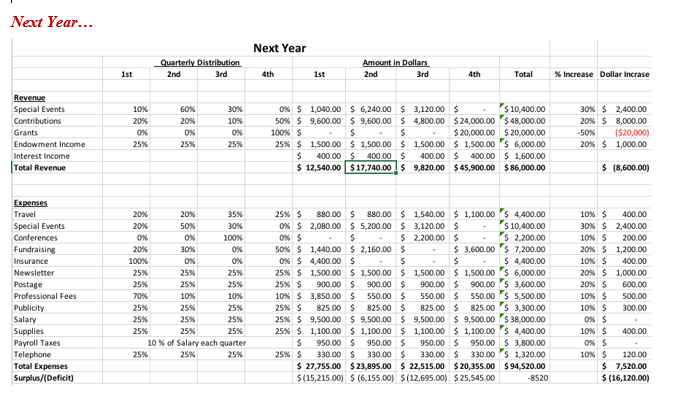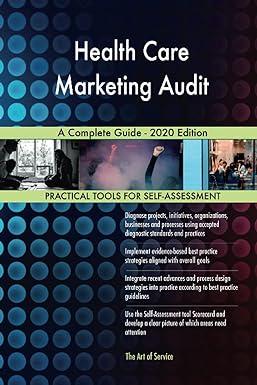Question
Chippewa Watershed Conservancy: Not-for-profit Budgeting Case II: Functional and Flexible Budgets Case II is a continuation of Case I. In this case you will convert
Chippewa Watershed Conservancy: Not-for-profit Budgeting
Case II: Functional and Flexible Budgets
Case II is a continuation of Case I. In this case you will convert the line-item budget developed in Case I into a functional budget. Then you will employ further information to create a flexible budget. Refer to the Case I Solution for data.
Assume that the CWC has adopted the budget as developed in Case I even though it does not hit the 5% budget surplus target. Now they want you to allocate the budget into functional areas. Revenue is not allocated to functions. However, expenses are allocated to functions using the percentages shown in the following section.
Part A: Functional Budget
Program Functions Stewardship: Management of easements and preserves.
Outreach: Publicity and Education.
General Program: Activities directly related to project development.
Support Functions
Administration: Management of the organization and other activities not directly related
to project development
Fundraising: Grant-seeking, special events, and fund appeals
P R O G R A M S U P P O R T
Stewardship Outreach General Administration Fundraising
Program
Expense
Travel 50% 10% 20% 10% 10%
Special Events 100%
Conferences 50% 50%
Fundraising 100%
Insurance 60% 20% 20%
Newsletter 80% 20%
Postage 10% 30% 10% 10% 40%
Professional Fees 50% 50%
Publicity 100%
Salary 30% 10% 30% 20% 10%
Supplies 30% 10% 20% 30% 10%
Payroll Taxes 30% 10% 30% 20% 10%
Telephone 30% 10% 30% 20% 10%
Questions for Part A:
1) Create a Functional Budget for the upcoming year. Use the revenue and expense allocations provided above and the Case 1 Solution for the next year.
2) What percent of the total expense budgeted by the CWC for the next year is spent in each of the five functional areas? What percent is Program expense (total of Stewardship, Outreach, and General Program) and what percent is for Support (Administration and Fundraising)?
Part B: Flexible Budget
The CWC budgeted on the basis of the existing 14 preserves and 27 conservation easements.
New refers to additional preserves and/or easements.
X% refers to the percentage of the original budget.
Add:
Travel: 3% for each new project in Stewardship
3% for each new project in General Program
Postage: 1% for each new project in Stewardship
1% for each new project in General Program
Professional Fees: 5% for each new project in General Program
Supplies: 1% for each new project in General Program
Telephone: 4% for each new project in General Program
Salary and Payroll Tax
Shift 3% from Administration to General Program for each new project
Note: 2% refers to the percent of the original budget. If the budget for a line-item is $1,000 and 10% is assigned to a particular function (such as General Program), then if an additional 6% is added to that function (due to 3 new projects with 2% per new project) the new budget for that function is [10% + (3 x 2%)] multiplied by the original budget for that line item. In this case, .16 x $1,000 = $160 while the budget for the entire line-item is $1,000 x 1.06 = $1,060.
No additional staff will be hired. The CWC plans to have some administrative duties performed by volunteers or deferred.
Questions for Part B:
3) Prepare a Flexible Budget for the five functional areas based on 3 new projects.
4) Calculate the budget surplus/deficit based on your Flexible Budget. Do not change revenue from the total column in the Case 1 Solution Cash Budget. Recalculate the budget surplus/deficit as a percent of total expense.
5) What percent of the new budget is Administration expense? What dollar amount?
6) Does it appear reasonable that the CWC can handle the level of activity described in question 3 without an increase in revenue? Why? Discuss any concerns.
Here is my Case #1 LINE ITEM BUDGET...

Step by Step Solution
There are 3 Steps involved in it
Step: 1

Get Instant Access to Expert-Tailored Solutions
See step-by-step solutions with expert insights and AI powered tools for academic success
Step: 2

Step: 3

Ace Your Homework with AI
Get the answers you need in no time with our AI-driven, step-by-step assistance
Get Started


